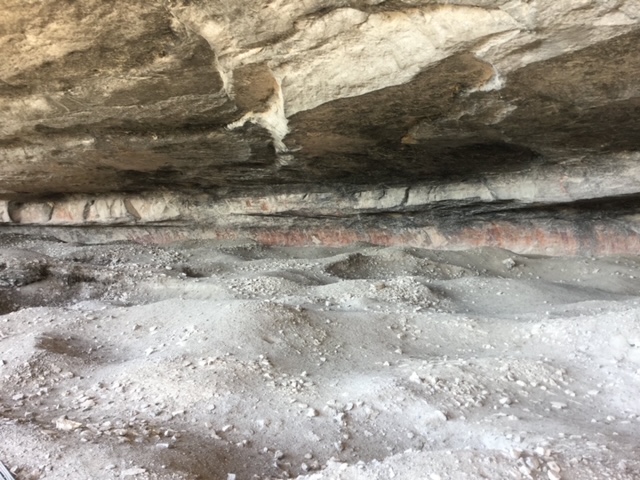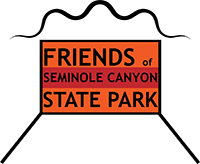Paleozoic to Modern Day
At SCSP History Runs Deep!
History layers and surrounds Seminole Canyon State Park.
The canyon walls lay bare the millions of years this area was beneath a shallow sea. Fate Bell shelter provides a unique view of the underside of a cretaceous reef, made not of coral but of rudist clams. The limestone rocks beside the pathway into Fate Bell are teeming with fossils easily overlooked when your goal is the pictographs to come.


Prehistory
The pictographs in Fate Bell Shelter, the Fate Bell Annex and the sheer wall of art in-between, are remains of cultures that lived in and around the Lower Pecos since the end of the last ice age. Inside area rock shelters, archaeologists have found evidence of ancient bison (1500 pounds heavier than today’s bison famously roaming Yellowstone National Park), mammoths, saber tooth tigers, small prehistoric horses, ancient camels and other giant fauna of the last ice age.
Most Southern “Bison Jump”
Nearby, is the oldest and the most southern “bison jump” in North America. More than 10,000 years ago peoples of the Lower Pecos drove a small number of ancient bison into a “v” shaped niche in the surface prairie and over a cliff. Thousands of bones remain tucked behind a rock fall in the protected shelter below.
(Picture at right: Fossilized bison bones protruding from floor of Bonfire Shelter.)


Fate Bell Shelter
The rock shelters protected and housed the peoples, that painted the beautiful Lower Pecos Rock Art, for thousands of years. Fate Bell Shelter, one of the largest occupied shelters in the region, is filled over 10 feet deep with the debris from daily living. That is a lot of debris for a “hunter gatherer” society living in groups of 25 or so.
The debris tells the story of life in the shelters and periodic changes in weaving (mats, sandals, bags) tool making, and local plant and wildlife. The Fate Bell shelter has been dug up repeatedly by relic hunters and is now a pock marked moonlike surface. Though no longer a reliable resource for archaeological research, the upended surface allows visitors to see thick layers of mats and woven materials half buried in the debris.
Fate Bell Shelter can be seen only on guided tours given Tuesday through Sunday at 10 am and 3 pm.
Join us! Register for a hike today.
“Lower Pecos” Style Rock Art
The majority of the pictographs in Fate Bell were painted between 1500 and 5000 years ago. That is a remarkably long period for the consistent style of painting known as “Lower Pecos”. The art includes stylized “anthropomorphs”, humanlike figures with animal attributes, large depictions of cats, deer, various enigmatic figures, forms and shapes that are consistently present. Today archaeologists at SHUMLA are trying to decipher the meaning of the symbols and Dr Carolyn Boyd, refers to these paintings as “North America’s first books.”

Historic Art
When the first Europeans came to America, few ventured into the Lower Pecos region and there are no references to the rock art in any early explorers’ accountings. But the arrival of the horse changed the culture of many native peoples and within 200 years tribes from northern North America had mastered the horse and traveled far and wide including into the Lower Pecos area. The historic art reflected this change showing mounted horsemen, figures of Spanish soldiers and missions with a cross atop the building.

Recent History
After the US Civil War, the US Army with the help of a special unit the “Seminole Negro Indian Scouts”, fought Comanche and Apache raiders across Texas. The unit was based in Ft Clark (now Bracketville, TX). The park is named for those Scouts whose heroism, at the mouth of the Pecos just a few miles from the park, earned them the Medal of Honor.
In the 1880’s the railroad first came through the region. Seminole Canyon State park was the site of a camp for the workers including a store and saloon. Remnants of the railroad era remain across the park and include the track base, a restored baking oven, a storage area where explosives were kept and historic graffiti where workers left their names on the canyon walls. More can be seen on the Upper Canyon tour.
In the 1800’s ranchers entered the Lower Pecos eager to graze the tall grasses. Little did they know this new grass and its tricky nature. Though lush when the first ranchers arrived, the grass did not return after grazing. The grass required occasional burning to stimulate reseeding and would die if cut or grazed too short. Much of the grass died out and the annual rains, without grass stabilizing the soil, washed the precious topsoil away.
Word of the Rock Art seeped back to the world and archaeologists and artists came to Fate Bell in the 1930’s. The University of Texas performed the first archaeological dig at Fate Bell shelter in 1932. Their report is available in the visitor’s center. Like many of the area shelters the layers of historical debris provided an intact record of life in the Lower Pecos over thousands of years.
Forrest Kirkland and his wife Lula spent many summers traveling across Texas documenting native people’s art by creating beautiful color paintings. Copies of his paintings are posted along the Fate Bell tour route to assist in identifying panels as much of the art has degraded in the past 80 years.

We welcome you to visit Seminole Canyon State Park to learn and explore millions of years of history.
For online tour information and registration click the button below.
